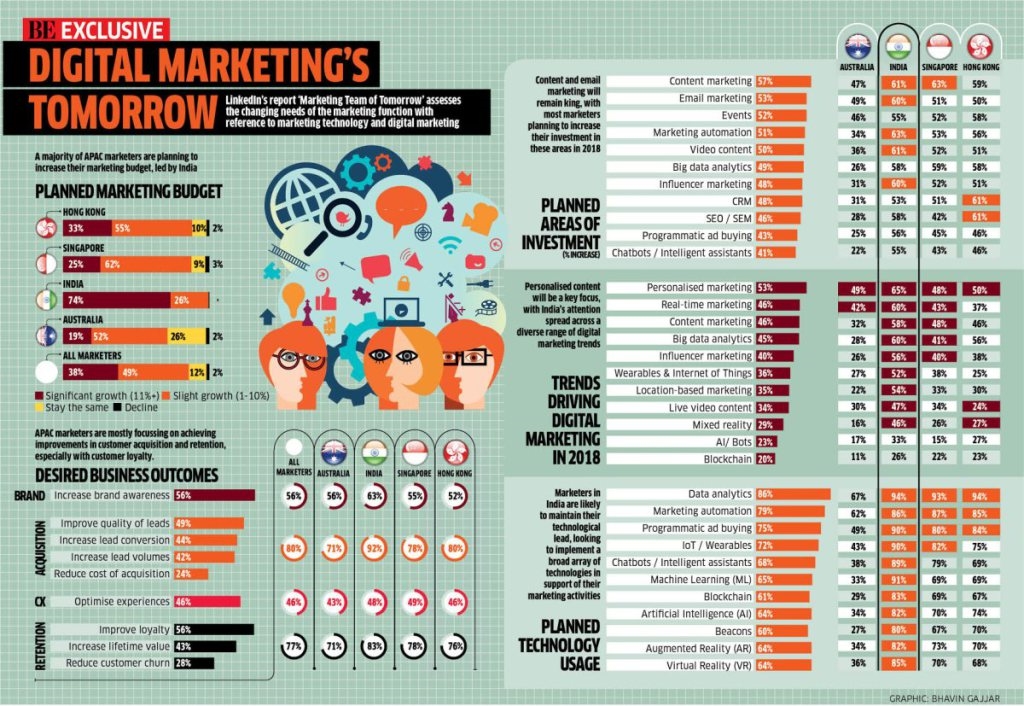— February 9, 2018

The infographic below is based on LinkedIn’s report of the marketing team of the future and highlights to changing landscape of digital marketing. Will the future for digital marketing look like the one we see today? If not, how will that future differ? How can companies get ahead of the changes in digital marketing to face the future successfully?
These are just a few questions that keep CMO’s and VP’s of Marketing up at night. Today, we’ll look at how digital marketing might look in the future and how companies need to build the skills necessary to compete in tomorrow’s digital marketing world.
There is no future for digital marketing
First, let’s get one thing straight. There is no future for digital marketing. Period.
Don’t get me wrong, I believe we’ll always see marketing on digital and mobile platforms. In fact, I think companies who aren’t already on these platforms may be so far behind, they’ll never catch up–becoming the dinosaurs whose carcasses we’ll find in a distant future at the bottom of some metaphysical tar pit.
What I mean is that all marketing is now, and forever will be digital marketing. Or, at a minimum, digital-first marketing. And the implications of this statement are far-reaching; impacting the way we train and criterion we use in hiring and evaluating marketing professionals.
That’s because digital marketing turned traditional marketing on its head. All marketing now involves components we didn’t really incorporate sufficiently until we moved into the digital realm. And, that’s a post for another day.
Here are major aspects that moved from digital marketing to just plain marketing:
- Analytics. You can no longer run a marketing program with squishy numbers like awareness and produce new products based on what the engineers can do. You need cold, hard facts to back up marketing decisions.
- Faster timelines. Agile and lean have changed how we develop new products. The name of the game is to fail fast and move on rather than taking months or years to develop products that no longer (or never did) have a market. You also can’t let customer complaints stew, rely on slow means to address customer questions, or pipe in on major news. Customer service must be always on and ubiquitous and you need to adjust your messaging on the fly when outside events call for it. Pricing has to be dynamic, based on current conditions.
- Use social as a listening post even if you don’t market there. This is an important element in your sense and respond process.
- Personalized marketing.
- Customer experience management.
How can companies embrace the concept of no future for digital marketing?
- Marketing professionals require different training so look for the following skills when hiring marketing staff:
- Excellent writing and editing skills
- Analytics skills, including data visualization, SQL, Google Analytics, and Adobe or other analytic tools
- Creativity and knowledge of design to create graphics, video, and other forms of content
- Online computer skills such as HTML, CSS, etc.
- These enhanced skills require commensurate increases in salaries, a commitment to continuous training, and flatter structures that push decisions to creators rather than long approval processes.
What happens to traditional marketing?
Traditional marketing, especially the concepts that underpin traditional marketing will always exist and are expanding through the research of dedicated academics and practitioners who constantly push the envelope of our knowledge. That doesn’t mean we’ll always have a place for traditional advertising, which, despite decades of telling students that advertising is but one (minor) aspect of marketing, is how the average business person views marketing.
What is traditional marketing?
- Consumers have always and will always go through a decision-making process influenced by peers, family, celebrities, etc. Understanding the circuitous (rather than linear) nature of that process and how influence, information, and recommendations guide it will always help marketers provide for more productive customer experiences that both make customers happy and translate into improvements in a company’s bottom line. That’s marketing.
- Pricing is important not only as an economic reality of exchange but because it guides customers in their choices. Contrary to the economic theory of the “rational man”, customers never did and never will choose products solely based on which product boasts the lowest price. Instead, pricing has a complex impact on customer decisions that must be understood fully to optimize profitability. That’s marketing.
- Producing high-quality products that consistently meet customer needs and innovating to produce products that meet customers’ future needs is critically important for firm success. Husbanding the firm’s resources and managing this process strategically and tactically is the difference between success and failure. That’s marketing.
And, I could go on, but you get the idea. The principles of marketing will never go away, although they might evolve and deepen over time.
How should companies embrace the reality of traditional marketing?
Hire marketing graduates.
There’s been a disturbing trend of hiring non-marketing students, because they’re cheaper, or quant folks, like engineers, because they can handle the analytics stuff. Neither of them knows a whit about marketing. Face it, marketing is a major because knowledge of marketing principles contributes value to an organization.
As educational institutions, that means we need to spend more time teaching APPLICATION of marketing principles and analytics.
Trends in digital (and mobile) marketing
Take a look at the graphic to look at the future for digital marketing. Here’s what you should see:
- More money
- More data and analysis
- Faster information, ie. real-time analytics
- More content and more varied forms of content
- Better customer experiences and more loyalty
- Better use of technology, such as bots, automation, and personalization tools
image courtesy of Brand Equity
How can companies embrace these trends?
You can’t get the skills necessary for digital marketing (or any type of marketing if you buy into my thesis that all marketing is digital), without a strong commitment to ongoing training, adequate compensation and motivational programs, and good management. Of course, none of this is really new.
Training students in the future for digital marketing
With the future for digital marketing–or simply marketing–gaining clarity, we need to think about how our marketing training should change to accomplish the goals of organizations of the future. As a marketing educator for over 20 years, here are my suggestions to administrators:
- Incorporate analytics training. Most marketing majors take marketing research, which is important, but not sufficient for today’s complex analytical needs. Students need at least 1 additional course focusing on digital analytics/ data visualization. Supporting courses to learn SQL are also needed. Plus, each course should contain a substantial analytics component that requires students to apply analytical techniques on the subject matter.
- More focus on application and depth of learning versus coverage of broad, superficial topics. Each class should involve doing, not (just) testing.
- Emphasis on acquisition of technical skills such as HTML, SQL, R. proper use of analytics software, etc.
- Develop design skills such as Indesign, Photoshop, Premier (Adobe) or similar tools plus theories of design.
Digital & Social Articles on Business 2 Community
(36)









